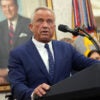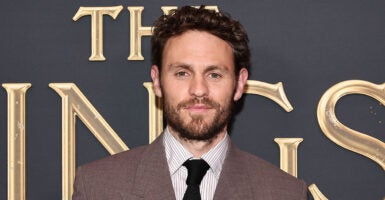Warning: This review contains spoilers for the Amazon series “The Lord of the Rings: The Rings of Power,” Season 2.
The second season of Amazon’s “Rings of Power” somehow managed to be worse than the first season of the show, which is a rather high bar.
The first season showed a disrespect for J.R.R. Tolkien’s world, but this season made things worse. It seems as if the showrunners don’t understand the basics of fantasy—or even storytelling.
Before I get into the great sins of the season, I’ll address a few smaller quibbles.
The second season introduced “the Faithful,” a religion in the kingdom of Numenor, and failed to give even the slightest taste of what the religion involves. It also introduced the barrow-wights (which the Peter Jackson movie adaptation of Tolkien’s “The Fellowship of the Ring” cut out).
There’s just one problem: the barrow-wights shouldn’t exist until far in the future of Middle Earth, because the person responsible for them—the Witch King of Angmar—hasn’t received his ring of power yet. It also presented the Palantiri, the seeing stones that made a big appearance in “The Lord of the Rings,” as corrupted when they don’t become corrupted until far in the future.
Yet these sins against Middle Earth pale in comparison to the great solipsisms of storytelling the show commits.
1. Sauron
Everyone and their mother in this show somehow knows that Sauron (the main villain in “The Lord of the Rings”) represents a vast ethereal evil on the horizon, yet the show doesn’t bother to give the audience a reason to fear Sauron.
Charlie Vickers gives Sauron a great presence on the silver screen, but the show’s horrible writing prevents the audience from truly fearing him.
Season 2 opens with a scene in which Sauron gives a speech to orcs, and Adar (Sam Hazeldine) proceeds to betray him, killing him with the very crown he was supposed to receive. Adar’s motive for that remains unclear, and Sauron transforms into a black goo—rightly mocked online as “Soupron”—only to slowly reemerge after eating a centipede, a rat, and a person.
The showrunners seemed to think this scene provided a cool backstory for the ultimate villain, but in reality, it made the audience see Sauron as impotent, unimpressive, and rather comical. “The Rings of Power” never spends time giving the brief mythic backstory of evil in Middle Earth, and it suffers for it.
The Peter Jackson adaptation of “The Lord of the Rings” begins with an excellent introduction to the world and the evil of Sauron, and it presents him as powerful and wicked, doing the work to establish the villain the audience almost never sees throughout that film trilogy.
“The Rings of Power,” by contrast, never gives the impressive and dark backstory, instead presenting Sauron as a schemer and deceiver. Only in a later episode of Season 2 does the audience see Sauron’s true power to deceive through illusions—and by then, the audience can’t help but think of Sauron as a pitiful pile of black goo.
2. The Orcs
“The Lord of the Rings” and Tolkien’s Legendarium always presented orcs as evil. They are fundamentally corrupt, and the audience should cheer when heroes slaughter them. “The Rings of Power” attempts at many points to humanize them, showing orcs with families and having one orc plead with the orc leader Adar to stop leading them to war.
In storytelling, subverting the audience’s expectations can be very powerful. Suddenly suggesting that characters the audience thought of as mindless drones are actually human beings with wills and lives can be effective, if the storytellers commit and actually strive to make a point. Similarly, redemption arcs can strongly resonate with audiences, and if an orc truly rejected evil and could somehow be redeemed, that might be an interesting story.
“The Rings of Power” never pursues either of these avenues. Instead, it resorts to a cheap trick, as the orc who expressed concern about the constant wars later betrays Adar in favor of Sauron, for no reasons given by the show.
The humanization of orcs is nothing but a bait-and-switch in “The Rings of Power,” and it’s a particularly unsettling one. This narrative device suggests that Tolkien and the heroes have been wrong to cheer the deaths of orcs all along, and then it reverts to form as if nothing had changed. Suddenly, later in the season, the heroes are slaughtering orcs left and right, and it’s supposed to be noble again.
Middle Earth is not the place to humanize orcs, and anyone remotely familiar with the source material should know that.
3. Why, Oh Why, Does Adar Hate Sauron?
The main conflict in Season 2 revolves around the elf Celebrimbor (Charles Edwards) forging the rings of power in the city of Eregion, under Sauron’s influence, while Adar leads a huge orc army to attack Eregion and kill Sauron.
Adar hates Sauron, for some reason, and he is even willing to team up with the elf heroine Galadriel (Morfydd Clark) to defeat him.
Adar tells Galadriel that he wants to kill Sauron so that he can lead the orcs back into Mordor and no longer attack the other peoples of Middle Earth. Galadriel understandably does not believe him.
At the end of the show, the orcs suddenly turn on Adar for no reason, just as Adar turned on Sauron for no reason at the beginning, killing him and pledging their fealty to Sauron.
Adar’s No. 1 lieutenant carries out the killing blow, but the show never explains how Sauron got him to betray his master. The entire plot feels pointless and unearned.
4. A Completely Nonsensical Battle
Episode 7, “Doomed to Die,” features the massive battle of Eregion, which pits the elves under Sauron’s control against the orcs under Adar. Other elves—Galadriel, Elrond (Robert Aramayo), and the High King Gil-Galad (Benjamin Walker)—arrive to fight against the orcs and save the city.
While fantasy, as a genre, does require certain willing suspension of disbelief, such as the idea that magic exists and there are elves, orcs, trolls, etc., it doesn’t usually involve suspending the laws of physics. That, however, is exactly what this battle does.
First, the orcs turn their trebuchets on a mountain, which immediately crumbles, causing huge boulders to fall into a river. These boulders somehow dam up the river completely, turning the river into dry ground. Yet anyone remotely familiar with rivers knows that not only is this a nearly impossible feat, but the riverbed would not immediately be dry—and it certainly wouldn’t be dry enough for the orcs, and then an army of elves on horseback—to march across it easily.
Second, when the elves charge on their horses, they get within a few feet of the orcs before Elrond sees that the orcs have Galadriel hostage. In order to save Galadriel, Elrond brings the entire army of cavalry to an immediate halt before they would charge into the orcs. Note to the showrunners: That’s not how horses work. If the war horses are charging, and you try to pull them back, it’s going to take time for them to slow down, and most likely, they are just going to keep charging.
Yes, Tolkien created a fantasy world where there are orcs, elves, dwarfs, hobbits, and more mythical creatures. But his horses never stopped being horses, his mountains never stopped being mountains, and his rivers never stopped being rivers. Fantasy requires the willing suspension of disbelief, but “The Rings of Power” requires the willing suspension of common sense.
It’s a shame the name of Tolkien has any connection to this monstrosity.































